
This is a list of ancient Roman temples, built during antiquity by the people of ancient Rome or peoples belonging to the Roman Empire. Roman temples were dedicated to divinities from the Roman pantheon.

This is a list of ancient Roman temples, built during antiquity by the people of ancient Rome or peoples belonging to the Roman Empire. Roman temples were dedicated to divinities from the Roman pantheon.
Most of the best survivals had been converted into churches and mosques. Rural areas in the Islamic world have some good remains, which had been left largely undisturbed. In Spain, some remarkable discoveries (Vic, Cordoba, Barcelona) were made in the 19th century, when old buildings being reconstructed or demolished were found to contain major remains encased in later buildings. In Rome, Pula, and elsewhere some walls incorporated in later buildings have always been evident. In most cases loose pieces of stone have been removed from the site, and some such as capitals may be found in local museums, along with non-architectural items excavated, such as terracotta votive offerings, which are often found in large numbers.
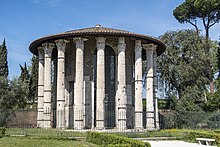
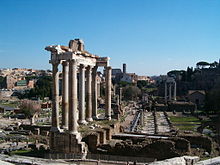


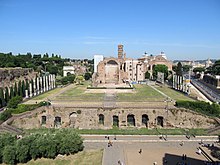



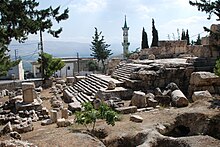

Not much remains to be seen, but there were temples at Ulpia Traiana Sarmizegetusa (6), [10] Alburnus Major (2), [10] Apulum, [11] Tibiscum [12] Porolissum [13] and probably Potaissa (suggested by five neighboring altars), as well as other sites. [10]








The Roman Forum, also known by its Latin name Forum Romanum, is a rectangular forum (plaza) surrounded by the ruins of several important ancient government buildings at the center of the city of Rome. Citizens of the ancient city referred to this space, originally a marketplace, as the Forum Magnum, or simply the Forum.

The Aventine Hill is one of the Seven Hills on which ancient Rome was built. It belongs to Ripa, the modern twelfth rione, or ward, of Rome.

The Capitolium or Capitoline Hill, between the Forum and the Campus Martius, is one of the Seven Hills of Rome.

Festivals in ancient Rome were a very important part in Roman religious life during both the Republican and Imperial eras, and one of the primary features of the Roman calendar. Feriae were either public (publicae) or private (privatae). State holidays were celebrated by the Roman people and received public funding. Games (ludi), such as the Ludi Apollinares, were not technically feriae, but the days on which they were celebrated were dies festi, holidays in the modern sense of days off work. Although feriae were paid for by the state, ludi were often funded by wealthy individuals. Feriae privatae were holidays celebrated in honor of private individuals or by families. This article deals only with public holidays, including rites celebrated by the state priests of Rome at temples, as well as celebrations by neighborhoods, families, and friends held simultaneously throughout Rome.

The Campus Martius was a publicly owned area of ancient Rome about 2 square kilometres in extent. In the Middle Ages, it was the most populous area of Rome. The IV rione of Rome, Campo Marzio, which covers a smaller section of the original area, bears the same name.

Ancient Roman temples were among the most important buildings in Roman culture, and some of the richest buildings in Roman architecture, though only a few survive in any sort of complete state. Today they remain "the most obvious symbol of Roman architecture". Their construction and maintenance was a major part of ancient Roman religion, and all towns of any importance had at least one main temple, as well as smaller shrines. The main room (cella) housed the cult image of the deity to whom the temple was dedicated, and often a table for supplementary offerings or libations and a small altar for incense. Behind the cella was a room or rooms used by temple attendants for storage of equipment and offerings. The ordinary worshiper rarely entered the cella, and most public ceremonies were performed outside where the sacrificial altar was located, on the portico, with a crowd gathered in the temple precinct.

The Forum Boarium was the cattle market or forum venalium of ancient Rome. It was located on a level piece of land near the Tiber between the Capitoline, the Palatine and Aventine hills. As the site of the original docks of Rome and adjacent to the Pons Aemilius, the earliest stone bridge across the Tiber, the Forum Boarium experienced intense commercial activity.

The Forum Holitorium or Olitorium is an archaeological area of Rome, Italy, on the slopes of the Capitoline Hill. It was located outside the Carmental Gate in the Campus Martius, crowded between the cattle market and buildings located in the Circus Flaminius.

The Capitoline Triad was a group of three deities who were worshipped in ancient Roman religion in an elaborate temple on Rome's Capitoline Hill. It comprised Jupiter, Juno and Minerva. The triad held a central place in the public religion of Rome.

The Temple of Jupiter Optimus Maximus, also known as the Temple of Jupiter Capitolinus was the most important temple in Ancient Rome, located on the Capitoline Hill. It was surrounded by the Area Capitolina, a precinct where numerous shrines, altars, statues and victory trophies were displayed.
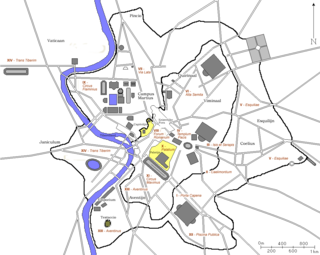
In 7 BC, Augustus divided the city of Rome into 14 administrative regions. These replaced the four regiones—or "quarters"—traditionally attributed to Servius Tullius, sixth king of Rome. They were further divided into official neighborhoods.
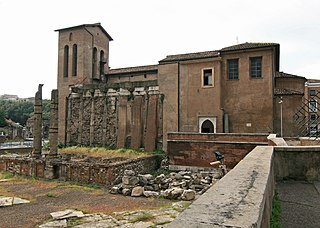
The Temple of Janus at the Forum Holitorium was a Roman temple dedicated to the god Janus, located between the Capitoline Hill and the Tiber River near the Circus Flaminius in the southern Campus Martius. The temple was built during the First Punic War, after the Temple of Janus in the Roman Forum.
Jupiter was king of the gods in the ancient Roman religion. Numerous temples were dedicated to him in Rome and throughout the Roman Empire. Notable examples include:
The Feriale Duranum is a calendar of religious observances for a Roman military garrison at Dura-Europos on the Euphrates, Roman Syria, under the reign of Severus Alexander.

The Temple of Jupiter Tonans was a small temple in Rome, dedicated by Augustus Caesar in 22 BCE to Jupiter, the chief god of ancient Rome. It was probably situated at the entrance to the Area Capitolina, the sanctuary of Jupiter on the Capitoline Hill, near the much older and larger Temple of Jupiter Optimus Maximus. The temple was considered among Augustus's most impressive archaeological projects, and played an important role in the Secular Games, a religious and artistic festival that he revived in 17 BCE. It was also noted by Roman authors for the artworks, particularly statues, displayed in and around it.
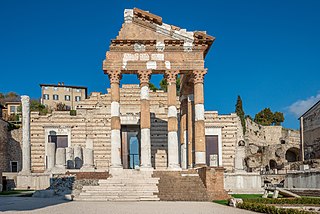
The Capitolium of Brixia or the Temple of the Capitoline Triad in Brescia was the main temple in the center of the Roman town of Brixia (Brescia), in Northern Italy, in the modern region of Lombardy. It is represented at present by fragmentary ruins, but is part of an archeological site, including a Roman theater and museum in central Brescia. It forms part of the Longobards in Italy: Places of Power UNESCO World Heritage Site inscribed in 2011.

The Regio VIII Forum Romanum Magnum is the eighth regio of imperial Rome, under Augustus's administrative reform. Regio VIII took its name from the Roman Forum, the political centre of Ancient Rome.

The Regio IX Circus Flaminius is the ninth regio of imperial Rome, under Augustus's administrative reform. Regio IX took its name from the racecourse located in the southern end of the Campus Martius, close to Tiber Island.

The so-called Dolicheneum is a temple in Dura Europos in the east of today's Syria, where Jupiter Dolichenus and god called Zeus Helios Mithras Turmasgade may have been worshiped. The remains of the temple were excavated in 1935/36, but results were never fully published.